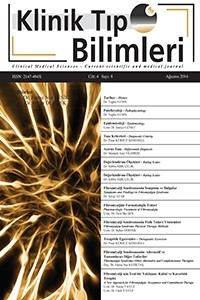Çocuk ve Ergenlerde Hipertansiyon:Son Gelişmeler Işığında Tanı ve Tedavi?
ÖzÇocukluk çağında hipertansiyon görülme oranı kilolu çocuk sayısının artmasıyla bir-likte önemli bir halk sağlığı problemi haline gelmiştir. Çocuklardaki yüksek kan basıncı-nın erişkin yaşamda devam ettiği gösterilmiştir. Bu durum hipertansiyon kontrolünün önemini daha da çok vurgulamaktadır. Hipertansif çocuğun değerlendirmesi yüksek kan ba-sıncının hastane dışında da teyit edilmesiyle başlar. Prenatal ve postnatal hipertansiyon nedenleri, hipertansiyon ile diyabet, kronik böbrek hastalığı, obezite ilişkisi ve ayaktan kanbasıncı izlemi kullanımı ile ilgili yeni bilgiler ile birlikte çocuklardaki hipertansiyonun etyolojisi ve farmakolojik tedavisi hakkında gelişmeler yaşanmıştır. Ne var ki, çocukluk çağıhipertansiyonunun erişkin dönemdeki kardiyovasküler komplikasyonlar üzerine etkisi ile ilgili olarak halen keşif bekleyen noktalar bulunmaktadır. Bu derlemede pediatrik hipertansiyon tanı ve tedavi üzerine güncel bilgilerin tartışılması amaçlanmıştır
Anahtar Kelimeler:
Çocuklar, Ergenler, Hiper-tansiyon, Tanı, Tedavi
Hypertension in Children and Adolescents: Diagnosis and Treatment in the Light of Recent Developments?
AbstractThe hypertension in childhood has become a major public health problem, as its prevalence is increasing in conjunction with the rise of number of the overweight children.High blood pressure in children has been shown to may persist into adulthood, and this emphasizes the importance of control. The evaluation of hypertensive children begins with the confirmation of high blood pressure outside the office measurements. There has been progress in the field of aetiology and pharmacologic treatment of hypertension in children with the introduction of new information for areas of pre and postnatal causes of hypertension; the use of ambulatory blood pressure monitoring in the evaluation of childhood hypertension and the relationship of obesity, diabetes and chronic kidney disease to hypertension.However, much is still to be discovered about the impact of childhood hypertension on adult cardiovascular end points. Current review aimed to discuss new aspects of paediatric hypertension regarding diagnosis and treatment.
Keywords:
Children, Adolescents, Hypertension, Diagnosis, Treatment,
___
- Kaynaklar 1.Sorof JM, Lai D, Turner J, et al. Overweight, ethnicity, and the preva-lence of hypertension in school-aged children. Pediatrics.2004;113:475–482. 2.McNiece KL, Poffenbarger TS, Turner JL, et al. Prevalence of hyperten-sion and pre-hypertension among adolescents. J Pediatr.2007;150:640–644. 3.National Heart, Lung, and Blood Institute. Report of the Second Task For-ce on Blood Pressure Control in Children 1987. Pediatrics 1987; 79: 1–25. 4.Bucher BS, Ferrarini A, Weber N, et al. Primary hypertension in child-hood. Curr Hypertens Rep 2013; 15:444–452. 5.Bao W, Threefoot SA, Srinivasan SR, Berenson GS. Essential hyperten-sion predicted by tracking of elevated blood pressure from childhood toadulthood: the Bogalusa Heart Study. Am J Hypertens 1995; 8:657–665. 6.Viera AJ, Neutze DM. Diagnosis of secondaryhypertension: an age-ba-sed approach. Am Fam Physician. 2010;82(12):1471–1478 7.National High Blood Pressure Education Program Working Group onHigh Blood Pressure in Children and Adolescents. The fourth report onthe diagnosis, evaluation, and treatment of high blood pressure in child-ren and adolescents. National Heart, Lung, and Blood Institute, Bethes-da, Maryland. Pediatrics 2004; 114:555.576. 8.Tumer N, Yalcinkaya F, Ince E et al. Blood pressure nomograms for child-ren and adolescents in Turkey. Pediatr Nephrol. 1999;13: 438-43. 9.Lurbe E, Cifkova R, Cruickshank JK ve ark. Management of high blo-od pressure in children and adolescents: recommendations of the Euro-pean Society of Hypertension. J Hypertens. 2009 Sep;27(9):1719-42. doi:10.1097/HJH.0b013e32832f4f6b. 10.Zanchetti A, Mancia G, Black HR, Oparil S, Waeber B, Schmieder REve ark. Facts and fallacies of blood pressure control in recent trials: im-plications in the management of patients with hypertension. J Hypertens2009; 27:673–679. 11.Daniels SR, Kimball TR, Morrison JA, Khoury P, Meyer RA. Indexingleft ventricular mass to account for differences in body size in childrenand adolescents without cardiovascular disease. Am J Cardiol1995;76:699–701 12.Litwin M, Niemirska A, Sladowska J, Antoniewicz J, Daszkowska J, Wi-erzbicka A, et al. Left ventricular hypertrophy and arterial wall thicke-ning in children with essential hypertension. Pediatr Nephrol 2006;21:811–819. 13.Jourdan C, Wu¨ hl E, Litwin M, Fahr K, Trelewicz J, Jobs K, et al. Nor-mative values for intima-media thickness and distensibility of large ar-teries in healthy adolescents. J Hypertens 2005; 23:1707–1715. 14.Barker DJ, Osmond C, Golding J, Kuh D, Wadsworth ME. Growth inutero, blood pressure in childhood and adult life, and mortality from car-diovascular disease. BMJ 1989; 298: 564.567. 15.Mitsnefes MM. Hypertension in children and adolescents. Pediatr ClinNorth Am. 2006 Jun;53(3):493-512, viii. 16.Alper Jr AB, Chen W, Yau L, et al. Childhood uric acid predicts adultblood pressure: The Bogalusa Heart Study. Hypertension 2005;45:34–8. 17.Laragh JH, Sealey JE. The plasma renin test revealsthe contribution ofbody sodium-volume content (V) and renin-angiotensin (R) vasoconstric-tion to longterm blood pressure. Am J Hypertens. 2011;24(11):1164–80.
- ISSN: 2147-494X
- Başlangıç: 2013
- Yayıncı: Selen Medya Yayıncılık Tanıtım ve Organizasyon Hizmetleri
Sayıdaki Diğer Makaleler
Tedavide İdeal Kombinasyonlar: Kime? Hangi Kombinasyon?
Tedavi Hedefleri: Ne Kadar Kabul Edilebilir?
Kimde Sekonder Hipertansiyon Aramalıyım?
Sağlıklı Beslenme –Neleri Gözden Kaçırıyoruz?
Çocuk ve Ergenlerde Hipertansiyon:Son Gelişmeler Işığında Tanı ve Tedavi?
“Hipertansiyon ve Egzersiz; İyi Ama Nasıl”
Obezitede Diyetin Düzenlenmesi
Hipertansiyonda Akılcı İlaç Tedavisi
Obezite Epidemiyolojisi ve Korunma
